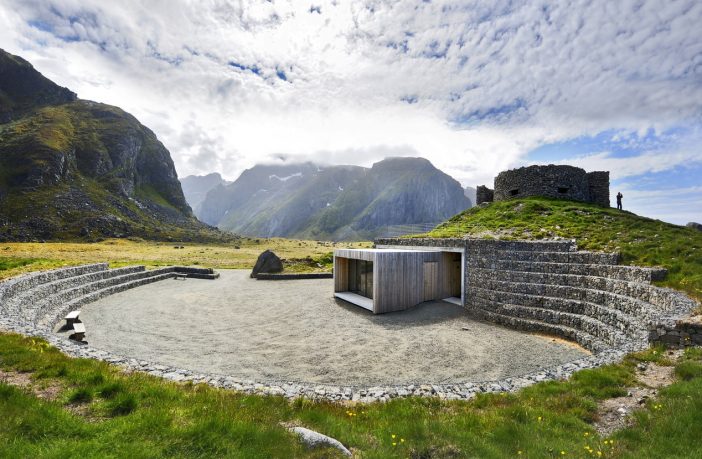- Building in nature constitutes a contradiction, as architecture enables immersive access to the landscape, while at the same time, natural landmarks are being slowly engulfed by tourists.
- The human presence in natural landscapes is an interplay of scales, a juxtaposition of archetypal shelters against the vast sceneries, as well as a negotiation between access to the landscape and environmental conservation.
- Exploring a variety of attitudes and formal strategies, the following takes a look at what could be learned from the experiences and design philosophies of several architects and practices that have perfected ways of addressing architecture in the landscape
The relationship of man to nature and of architecture to the landscape is continuously renewed, and architecture built within the natural landscape represents a certain kind of poetic exploration, as well as a renewed perspective on the human scale. The current architecture in the landscape is the product of a specific view of the relationship between human beings and nature. More than ever today, there is an awareness of the landscape as a precious heritage that architecture can and should enhance while protecting it to be passed on to future generations. The myriad of briefs and design proposals for objects in natural settings, be it cabins, observation towers, shelters that are a constant in the architectural news chicle reflect an ongoing preoccupation with a mindful creation of habitable places in the landscape.

Worldwide, the growing appetite for natural tourism raises some pressing practical issues concerning the managing of visitors. The Norwegian Trollstigen tourist route attracts more than 700.000 visitors, while only being accessible for three months each year, and Iceland’s rise in popularity as a natural tourism destination has led to enormous growth in tourist numbers, from 470.000 in 2010 to almost 2 million visitors in 2019. These examples underline architecture’s role and responsibility in updating these sites while mitigating the destruction of the environment by promoting a sustainable approach to natural settings. Distilling the ideas and design methods of several architects and their projects, the following represents a framework for building in the landscape, juxtaposing architecture and nature and underlining the intrinsic qualities of both.

Learn the Landscape

In the essay Architecture and Landscape, from the book Thinking Architecture, Peter Zumthordescribes his personal process of designing for natural settings, emphasizing learning the landscape as a prerequisite for the architectural endeavour. Zumthor underlines the need to search for the right balance in terms of materials, size, and shapes. Admittedly, this equilibrium relies on the sensibility of the architect, stating: “I venture to claim that we all immediately sens if the relationship between the building and the landscape in which it has been placed is disrupted if the landscape is enriched through the architectural intervention”. Zumthor also draws from his extensive experience to advise the use of clear, unambiguous typologies, as well as to match the substance of the landscape, with materials and construction techniques relating to the place, thus ensuring that the building ages well.
Re-Discover the Wisdom of Vernacular Architecture

Drawing inspiration from the local building culture, the Wadden Sea Centre designed by Dorte Mandrup Architects is a perfect embodiment of its landscape. The thatched roof sourced locally becomes a material ready to be sculpted, allowing the creation of an abstract shape. Through its colours and morphology, the building merges with the landscape. Moreover, the project works with and not against the local climate, as the inner courtyard shielded from the wind is also an adaptation to the landscape, as well as a borrowed element from the vernacular architectural tradition.
Shape a Novel Experience of Nature

Norwegian studio Reiulf Ramstad Arkitetker has a considerable number of thoughtful landscape interventions in its portfolio and organizing the experience of the landscape seems to be the common thread informing their projects in nature. With the Selvika intervention, the practice redefines the experience of reaching the seaside from the main road, intentionally slowing down the movement, carving a sinuous path that makes visitors aware of their surroundings, shaping their approach to the destination place and refocusing their attention. The project turns a very pragmatic need for infrastructure- accessibility, public toilets, benches- into an opportunity to create an experience.
Minimize Interventions

This past summer, Aedes Architecture Forum held an exhibition dedicated to architecture in natural settings, which presented Snøhetta’s pioneering projects that establish a dialogue with the landscape. On this occasion, Kjetil Trædal Thorsen, co-founder of the studio, stated: “some remote areas are becoming especially attractive to the ever-increasing desire of people to be part of something authentic.[…] For the places already under pressure, it will be vital to provide facilities preventing further destruction.” This is precisely what projects like Eggum Tourist Route manage to achieve, providing touristic infrastructure in a discreet architectural form. Moreover, Perspectives Panorama Trail curates the touristic experience with a minimum amount of intervention, through a series of architectural elements blending seamlessly within the alpine landscape.
Work with the Local Climate

For Dorte Mandrup Architects, the common ground of their architecture in natural settings seems to be the direct connection between the climate conditions of the place and the employed typology. The Icefjord Centre represents a clear response to the landscape and its climate conditions, with the boomerang shape helping to protect the building from the build-up of snow. Inserted within an almost a scalar landscape and informed by the Danish wood construction heritage, the project is meant to provide a platform for viewing the ice fjord, while also educating tourists about the area and climate change through its exhibitions.

This type of architecture discussed so far organizes human experience of the landscape, frames opportunities for interacting with nature, mediates and carefully superimposes smallness against the vastness. Such designs reconnect the practice to the essence of architecture, re-anchoring it in the realities of the environment.
Author: Andreea Cutier
This article was first published in Arch Daily and is republished with permission.











